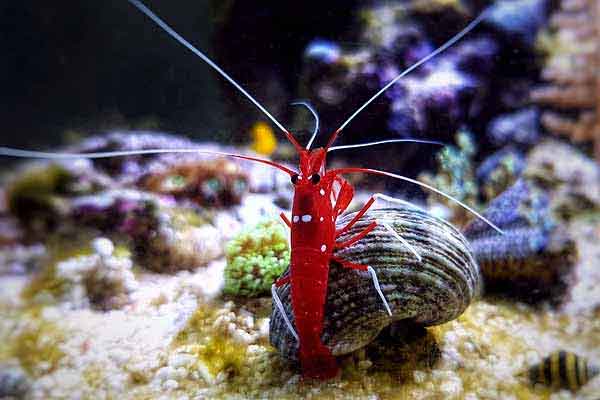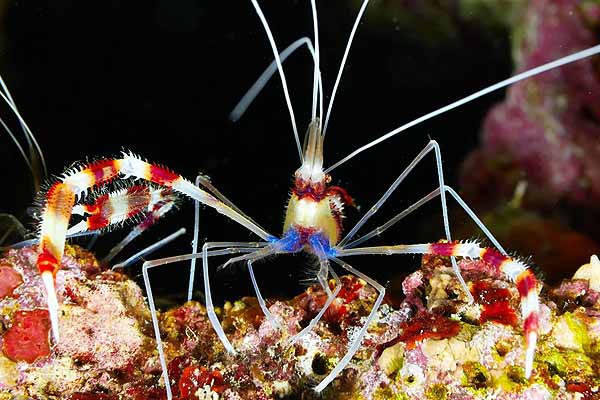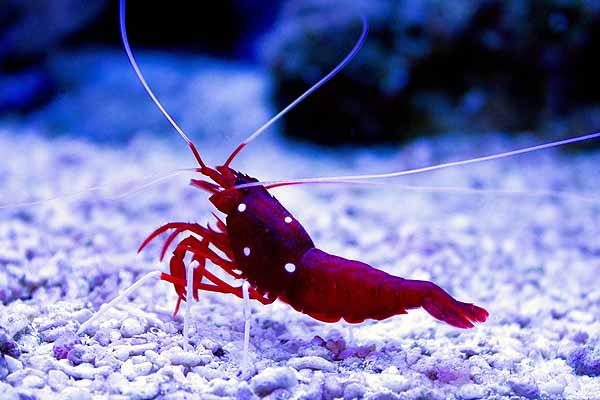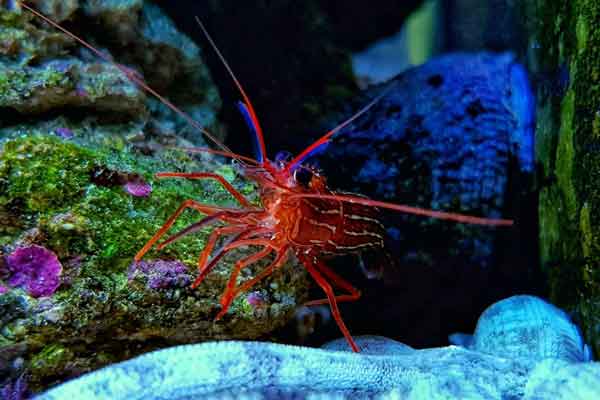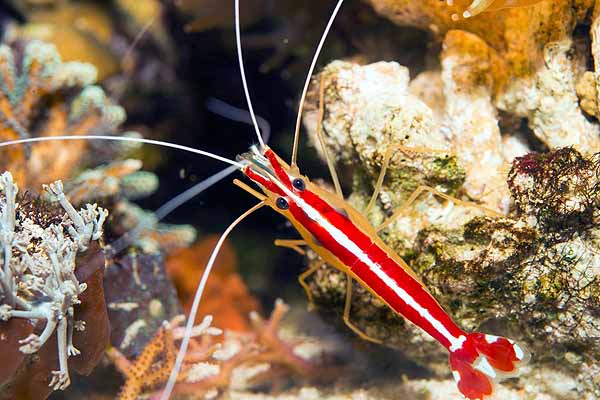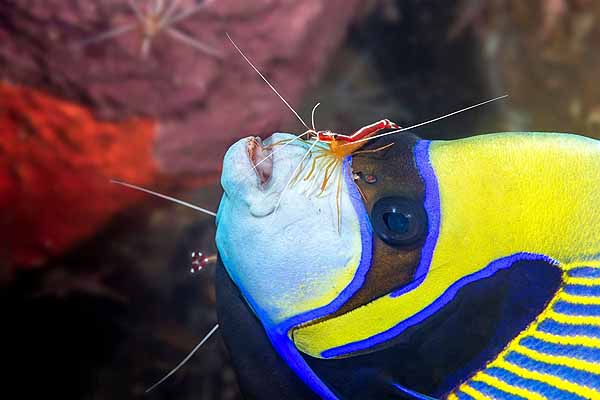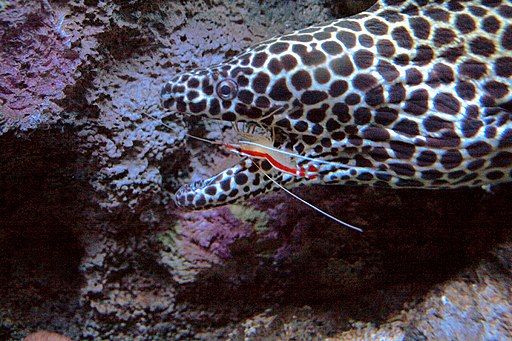[ad_1]
Are you looking for the perfect Saltwater Cleaner Shrimp to add to your reef tank, but aren’t sure which one to buy? Or do you just want to learn more about these amazingly beautiful invertebrates? Well, you’re in the right place, because these delicate creatures are amazing. Don’t take my word for it here, scroll down, you’ll see.
Table of contents: Cleaner shrimp
You can use the following links to jump right to the section that interests you most about Saltwater cleaner shrimp in a saltwater aquarium, or keep going, to read the full article.
Aquarium care facts
- Common names: There are several different types. Some of the most common names are: Coral banded or Boxer, Blood Red or Fire, Peppermint, Skunk
- Scientific names: Of the species listed above Stenopus hispidus, Lysmata debelius, Lysmata amboinensis, Lysmata wurdemanni
- Lifespan in a home aquarium: A few years (2-4) is likely typical, healthy; 9+ has been reported from the ultra-successful, of course, anything in between is possible
- Minimum tank size: 5-gallons (19 liters) +
- Diet: Carnivorous (meaty foods), varies by individual species but generally includes parasites, dead fish tissue, and mucus. Feed them deliberately with meaty marine foods.
- Price: Peppermint shrimp can be acquired from about $10-$20, Coral banded shrimp from about $15-$25, Skunk cleaners from about $25-$40, and Fire shrimp for $40+
- Saltwater Cleaner shrimp reef safe? Yes, all the species above are generally considered reef safe, although some individuals may pick at and annoy or destroy coral polyps or clam mantles
- Preferred aquarium conditions: Standard reef aquarium water parameters apply— tropical temperature ~76-80 degrees Fahrenheit (24.5-26.5 Celsius), pH ~8.2, specific gravity ~1.025, undetectable nitrates, absolutely no copper (kills invertebrates, including shrimp), and subdued lighting
The hardiest and most popular saltwater aquarium cleaner shrimp species
The two groups of saltwater cleaner shrimp that are easiest to care for and feed are from the Lysmata and Stenopus Genera. This includes the Boxing, Peppermint, Fire, and Skunk shrimps. In each of the species-specific sections, below, a relative price range is provided–please note that these prices are just a general range–you will see sales and/or premium prices throughout the year, but hopefully this guide helps give you a good idea to start with.
Coral Banded (Boxing) Shrimp
Perhaps the boldest and most aggressive of the invertebrates on his page, the Coral banded shrimp is an inexpensive and attractive option.
- Size: 3-inches (7-8 cm)
- Price: $15-$25
For more information about this Stenopus shrimp, check out this care guide: Coral banded shrimp
Blood Red Fire Shrimp
The Blood red fire shrimp is the most expensive and colorful invertebrate in his group. They are a hermaphrodite–each shrimp has both male and female reproductive organs.
- Size: 2-inches (~5 cm)
- Price: $40+
To learn more, check out this Fire Shrimp Care Guide.
Peppermint Shrimp
Most often purchased because of their low cost and aiptasia-eating tendencies, the Peppermint shrimp is also considered to be a cleaner.
- Peppermint shrimp are hermaphrodites–each shrimp has both male and female reproductive organs
- Size: 2-inches (5 cm)
- Price: $10-$15
Want to learn more about how to care for this invert, check out this guide about Peppermint shrimp care.
Scarlet Skunk Cleaner Shrimp
Beautiful, hardy, tolerant, can be kept as a single individual or as a pair or group. The most likely to demonstrate the cleaning behavior in the tank. Supplement diet with feeding meaty foods or they may starve.
- Scarlet cleaner shrimp are hermaphrodites–each shrimp has both male and female reproductive organs
- Size: 2-inches (5 cm)
- Price: $24-$40
If you want to learn more, check out this guide written about the Scarlet skunk cleaner shrimp care
Diet: what do they eat? Cleaner shrimp diet and the food they eat
Cleaner shrimp are carnivorous invertebrates, meaning that their diet consists of meaty marine foods. From their cleaning activities/behaviors, they benefit from the addition of parasites, skin, and mucous to their diets. The mucous is so important, it is even believed to be part of what drives certain cleaner species to preferentially choose certain individuals or species to clean. But you should not rely on the cleaning behavior alone to meet their full nutritional needs alone. Feed them routinely with prepared frozen foods, flakes and pellets, to ensure they get an adequate amount of calories and nutrition.
Will cleaner shrimp eat algae?
No, generally speaking, saltwater cleaner shrimp will not eat an appreciable or particularly helpful amount of algae, they are carnivorous and their natural diet is animal-based foods, not algae. This is sometimes a little confusing because it is easy/convenient to lump all the shrimp, crabs, and snails into the “clean-up-crew” category, but there are many invertebrates, including the cleaner shrimp that are carnivorous and won’t help keep problem algae under control beyond the indirect benefit of cleaning up meaty foods that might otherwise contribute to the water pollution that, if left to rot, would cause a spike in nitrates and potentially fuel the algae growth.
Will they eat ich? Parasites?
While it may not be a preferred food, saltwater cleaner shrimp will eat ich and other parasites off of the scales and gills of a saltwater fish. A word of caution, however, is that the presence of a cleaner shrimp species is not likely to be enough to keep a saltwater ich infestation under control. As mentioned earlier in this article, each of the different species of cleaner shrimp has a different level of zeal with which they will attempt to clean the fish in your tank, ranging from nearly total disinterest (in a captive setting) to very aggressive about it.
There is also no guarantee of a good fit between the shrimp and fish in your tank. Saltwater cleaner shrimp are also sometimes specific (picky) about the fish species they will clean and some fish are reluctant to receive cleaning services from a resident shrimp. Unfortunately, the ich probably will reproduce exponentially in your tank, while the dance plays out.
In summary, yes, cleaner shrimp will/may eat parasites like ich, but cannot be relied upon for eradication of the problem.
Will they eat aiptasia?
The Peppermint shrimp is a saltwater cleaner shrimp species that is often added to a reef tank because they will eat aiptasia anemones. The other species listed here (Coral banded shrimp, Skunk cleaner, Fire shrimp), will not likely help you out by eating aiptasia if that’s a problem you have in your tank.
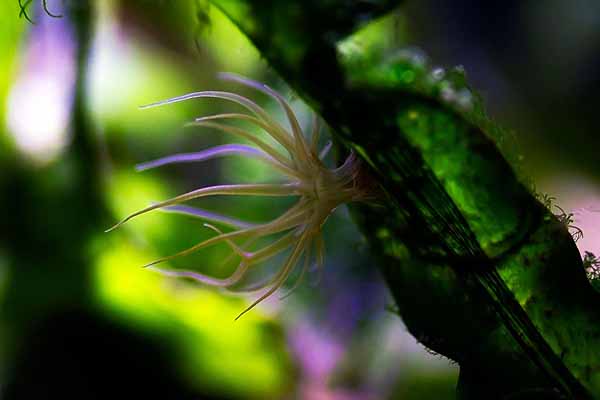
In addition to occasionally providing cleaner services, the Peppermint shrimp may also help by eating aiptasia anemones
Do they need to be fed and what?
Saltwater cleaner shrimp are carnivores and therefore need to be fed meaty foods, like brine shrimp, mysid shrimp, and other prepared foods. They will also learn to eat flakes or pellets that drift by in the current, using their antennae to either detect and/or direct floating food towards their front pincers. You should not rely on their cleaning behavior to fully meet their nutritional needs.
How big do they get?
Red skunk cleaners, Peppermints, and Fire shrimp all grow to about 2 inches (5 cm) in total length as adults (not including the antennae). Coral banded shrimp are a bit larger and grow to be about 3 inches (7-8 cm) in length and also seem larger, in general, because their front claws are spread out and crab-like.
Cleaner shrimp cleaning fish
One of the most enjoyable things you can do in this hobby is watching a cleaner shrimp cleaning fish. But don’t take my word for it, check out this popular video from YouTube of a cleaner shrimp cleaning fish. I’ll wait right here until you’re back.
a
Your best bet, if you’re want to observe the cleaning behavior in your tank is to go with the Scarlet skunk cleaner (Lysmata amboinensis)
Will they get ich or are they safe from it?
Saltwater ich does not affect cleaner shrimp–they will not become infected if you have those parasites in your aquarium. For that reason, they are a better choice than Neon gobies or Bluestreak cleaner wrasses, because those fish are susceptible to becoming infected by the water-borne parasitic ich.
Cleaner shrimp care in a saltwater aquarium
Proper saltwater cleaner shrimp care begins the moment they arrive at your home. These delicate creatures must first be acclimated to the conditions in your reef tank. From there, you need to create and maintain the optimal aquarium conditions, including ensuring compatibility with their tank mates and meet their diet and feeding requirements.
How to acclimate
Cleaner shrimp are delicate creatures, susceptible to shock (and death) if they are not properly acclimated to the aquarium conditions before being added to your tank. If you received a shipment from an online retailer, your best bet there is to follow their instructions, very thoroughly, to ensure you get the guarantee.
In the event that you purchased your shrimp from a local fish store, here a few tips for acclimation.
- Float the bag in your aquarium, for about 10-15 minutes, to adjust the temperature in the bag and then the water in your tank.
- Then, using the Accudrip acclimator, or several feet of airline tubing, start a drip from your quarantine or display tank into the bag, with a flow rate of about 4-8 drips per second.
- The Accudrip has a little device to constrict the flow to your desired flow rate.
- If you’re using airline tubing, just tie a knot and loosen or tighten to achieve the desired drip rate (4-8 drips per second)
- When the volume doubles, remove half the water and continue, for about an hour.
- Scoop your shrimp out gently, with a hard plastic container and gently introduce them to your tank by submerging the container and letting them swim out.
Preferred aquarium conditions
Cleaner shrimp care depends on your ability to create and maintain stable reef aquarium water parameters.
- Temperature: 73-82 Fahrenheit
- pH: ~8.0-8.2
- Salinity: 1.025
- Ammonia, Nitrates, Nitrites: 0 ppm
- Copper: Absolutely no copper, even in the aquarium previously
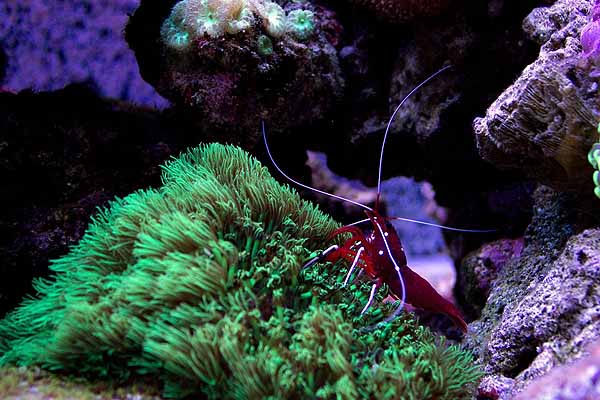
If it’s suitable to grow corals it should be suitable for saltwater cleaner shrimp
Will they jump? Do they need a lid?
It’s generally a good idea to have a tight-fitting lid or an edge guard to help prevent the animals in your tank from jumping out, I do not think this is a huge risk for these invertebrates. They can be frightened, and will erratically swim away, but it is unlikely that they would end up on the carpet.
They can be excessively shy
One of the biggest disappointments I have experienced (that wasn’t associated with the death of one of my animals) was when I found out how shy some individuals can be. Over the years, and unfortunately, there have been a lot of years, I have had the pleasure of keeping all of these amazing animals–but I was devastated when I found out how shy they can be. A few individuals rarely showed themselves (to me, at least), after plunking down ~$50.
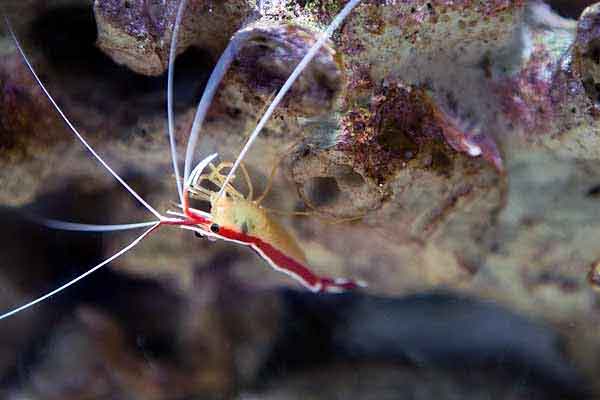
Creating ledges like this, out in the open, is a great way to encourage shy shrimp to be visible
That doesn’t mean they’re not worth it–they are–but buyer beware, they can be quite shy and the individual you get might spend the majority of their time hunkered down on the underside or backside of your live rock, out of sight. So a great way to lean into this otherwise healthy and normal behavior is to provide some live rock ledges, in primary viewing areas, so that you can see them even when they are being a bit shy.
Molting
Proper cleaner shrimp care also involves creating the conditions appropriate for molting.
If you are reading this blog post, chances are pretty solid that you are a mammal, with a skeletal system. When we grow, our bones actually get longer and stronger. Invertebrates, like saltwater cleaner shrimp, don’t grow in the same way. They are invertebrates–they don’t have a spine or bones. Instead, they have a hard outer shell or exoskeleton. When their outer skeleton is outgrown, they actually break out of it, shed it, in a process called molting.
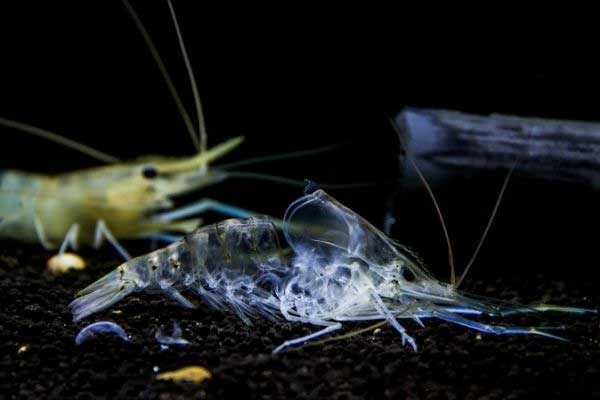
Take a look at the ghost-like abandoned exoskeleton. This process is called molting
So if you see something that looks like the withered, empty carcass of your beloved invertebrate friend–hang in there–it’s likely that it is the withered, empty carcass (or carapace) of your saltwater cleaner shrimp, and hopefully the shrimp is just hiding within the live rock somewhere waiting for their new shell to harden.
It is also recommended that you leave the exoskeleton in the tank–the shrimp may eat some of it (and reabsorb some of the lost nutrients).
Are cleaner shrimp reef safe or not?
Yes, the popular saltwater cleaner shrimp species are reef safe. One species to look out for, that looks like a popular species but is NOT reef safe is the camel shrimp. It is often confused for the reef-safe peppermint shrimp, but unfortunately has a bad track record of eating corals.
Compatibility
Proper saltwater cleaner shrimp care also involves insuring you keep them with the right invertebrates and fish. Some would-be predators can otherwise be tamed, while other predators will still gladly make a snack of them, under the right conditions. This section will hopefully provide answers to some of the most common compatibility-related care questions.
Keeping more than one cleaner shrimp
Can you keep fire shrimp and skunk cleaner shrimp together? Will they fight? Can you keep cleaner shrimp (presumable skunk) and peppermint shrimp–will one kill the other? These are good questions to consider before you add one to your tank.
You can expect to safely keep a group of Peppermint, Skunk, or Fire shrimp together (either as species-specific groups, or mixed). Coral banded shrimps, however, are a lot more aggressive, and a bit more complicated. When keeping coral banded shrimp, only keep a single specimen, or a mated pair, otherwise, they might actually be quite aggressive towards other shrimp in the tank (Calfo and Fenner 2003).
Can they kill fish?
No, a cleaner shrimp will not kill a fish. It would be an extremely rare event if that was the case. They are carnivorous and opportunistic eaters, so it is conceivable that if a fish died from some other means, in your aquarium, the carcass would potentially attract a cleaner shrimp and other invertebrates, but it would be extremely unlikely for your cleaner shrimp to be responsible for the death.
Will flame hawkfish kill cleaner shrimp?
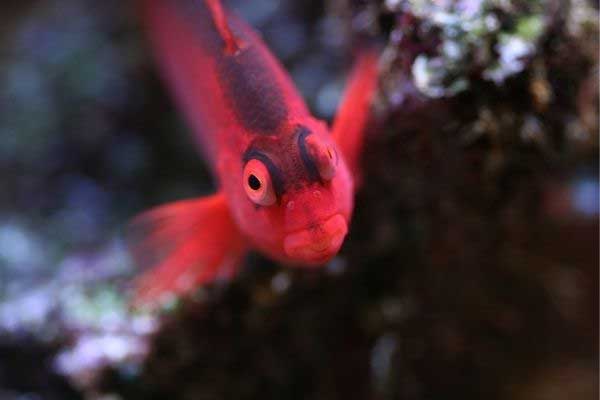
Flame hawkfish and related species are saltwater cleaner shrimp predators
The flame hawkfish is a predator of invertebrates. They are generally considered to be NOT compatible with small inverts, like saltwater cleaner shrimp. It is possible that you could luck-out and have a hawkfish and a shrimp that get along…almost all of the time…until that one time they didn’t get along.
Will an anemone kill and eat cleaner shrimp?
Most marine animals have a surprising instinct to avoid predatory anemones–however, mishaps do happen, and it is possible that your saltwater cleaner shrimp could be eaten by an anemone. But the same could be said for any of your small fishes. So if you plan to keep the two together, caution is advised.
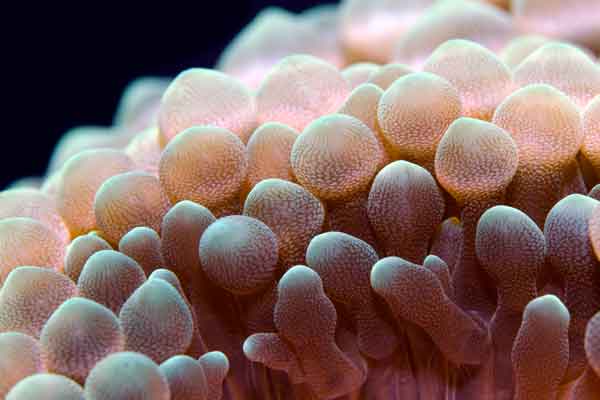
an anemone will eat a shrimp if they get a chance–hopefully, your invert won’t give it the chance
What to do if your shrimp dies?
Remove the carcass from the aquarium–also, watch carefully, and hope. Shrimp molt, which means they shed their outer skeleton, so it is possible the carcass you think is a dead cleaner shrimp might actually just be the hard outer skeleton.
Cleaner shrimp eggs, babies & breeding
Raising baby saltwater cleaner shrimp is technically possible, it has been done before, but it is not an easy endeavor. Some of the shrimp species on this list are simultaneous hermaphrodites, which means that each individual possesses both sets of reproductive organs, which means that sometimes the individual specimen you bring home may actually be carrying fertilized eggs–and if you bring home more than one individual, you could (should?) end up with a breeding pair.
However, fertilizing eggs and hatching larvae is just half of the battle (G.I. Joe). The rest of the battle is raising the larvae through multiple metamorphoses.
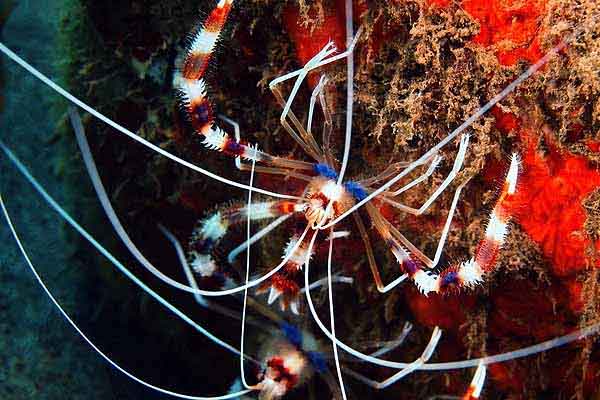
A mated pair like this can be expected to spawn, release eggs and larvae into the tank
If you are serious about raising your cleaner shrimp eggs into little baby shrimp, I recommend you check out How to Raise & Train Your Peppermint Shrimp.
Conclusions
Do you agree with me that the Saltwater Cleaner Shrimp are some of the most amazing creatures on the planet? It is amazing to think that an invertebrate that would otherwise be on nearly every oceanic animal’s dinner menu can flip the script because of the value they bring. In terms of aesthetic beauty, all of the inverts covered here will add delicate beauty, character, and depth to your reef tank–but if your primary goal is to observe the cleaning behavior in your aquarium, your best bet is to add the Scarlet Skunk Cleaner.
Do you want to Build a Better Saltwater Aquarium?
Join thousands of others in the Saltwater Aquarium Blog Community to get your questions answered, and I’ll even send you a free e-Book.
Join now
What to read next
Cleaner shrimp are an awesome option, but not the only option to observe cleaning behavior in your reef tank. You could also add a cleaner fish species. Dive deeper into the subject and check out two very popular saltwater fish cleaners:
Or if you want to learn more about other sensational saltwater shrimp, you can check out the amazingly beautiful:
References
Anthony Calfo and Robert Fenner (2003) Reef Invertebrates: An Essential Guide to Selection, Care and Compatibility, 2nd edn., Monroeville, PA: Reading Trees and Wet Web Media
Julian Sprung (2001) Invertebrates: A Quick Reference Guide, 1st edn., Miami, FL: Ricordea Publishing.

[ad_2]
Source link

